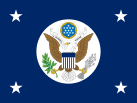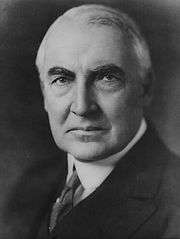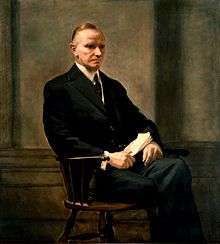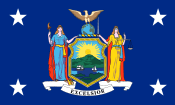Charles Evans Hughes
| Charles Evans Hughes | |
|---|---|
 | |
| 11th Chief Justice of the United States | |
|
In office February 13, 1930 – June 30, 1941 | |
| Nominated by | Herbert Hoover |
| Preceded by | William Taft |
| Succeeded by | Harlan Stone |
| 44th United States Secretary of State | |
|
In office March 5, 1921 – March 4, 1925 | |
| President |
Warren Harding Calvin Coolidge |
| Preceded by | Bainbridge Colby |
| Succeeded by | Frank Kellogg |
| Associate Justice of the Supreme Court of the United States | |
|
In office October 10, 1910 – June 10, 1916 | |
| Nominated by | William Taft |
| Preceded by | David Brewer |
| Succeeded by | John Clarke |
| 36th Governor of New York | |
|
In office January 1, 1907 – October 6, 1910 | |
| Lieutenant |
Lewis Chanler Horace White |
| Preceded by | Frank Higgins |
| Succeeded by | Horace White |
| Personal details | |
| Born |
April 11, 1862 Glens Falls, New York, U.S. |
| Died |
August 27, 1948 (aged 86) Osterville, Massachusetts, U.S. |
| Political party | Republican |
| Spouse(s) | Antoinette Carter |
| Children | 4 (Charles) |
| Alma mater |
Colgate University Brown University Columbia University |
| Religion | Northern Baptist |
| Signature |
 |
Charles Evans Hughes, Sr. (April 11, 1862 – August 27, 1948) was an American statesman, lawyer, and Republican politician from New York. He served as the 36th Governor of New York (1907–1910), Associate Justice of the Supreme Court of the United States (1910–1916), United States Secretary of State (1921–1925), a judge on the Court of International Justice (1928–1930), and the 11th Chief Justice of the United States (1930–1941). He was the Republican nominee in the 1916 U.S. Presidential election, losing narrowly to incumbent President Woodrow Wilson.
Hughes was a professor in the 1890s, a staunch supporter of Britain's New Liberalism,[1] an important leader of the progressive movement of the 20th century, a leading diplomat and New York lawyer in the days of Harding and Coolidge, and was known for being a swing voter when dealing with cases related to the New Deal in the 1930s.[1] Historian Clinton Rossiter has hailed him as a leading American conservative.[2]
Biography
Early life and education
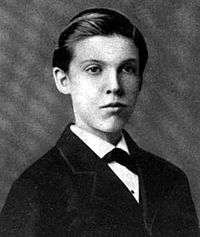
Charles Evans Hughes was born in Glens Falls, New York, the son of a Welsh immigrant minister Rev. David C. Hughes and Mary C. (Connelly) Hughes, a sister of State Senator Henry C. Connelly (1832–1912). He was active in the Northern Baptist church, a Mainline Protestant denomination.
Hughes' early education included attending Lafayette School in Newark, NJ. At the age of 14, he enrolled at Madison University (now Colgate University), where he became a member of Delta Upsilon fraternity. He then transferred to Brown University, continuing as a member of Delta Upsilon. He graduated third in his class at the age of 19, having been elected to Phi Beta Kappa in his junior year. He read law and entered Columbia Law School in 1882, where he graduated in 1884 with highest honors.[3] While studying law, he taught at Delaware Academy.
In 1885, Hughes met Antoinette Carter, the daughter of a senior partner of the law firm where he worked, and they were married in 1888. They had one son, Charles Evans Hughes Jr. and three daughters. Their youngest child, Elizabeth Hughes Gossett, was one of the first humans injected with insulin, and later served as president of the Supreme Court Historical Society.[4] Hughes was the grandfather of Charles Evans Hughes III and H. Stuart Hughes.
Early career
After graduating Hughes began working for Chamberlain, Carter & Hornblower where he met his future wife. In 1888, shortly after he was married, he became a partner in the firm, and the name was changed to Carter, Hughes & Cravath. Later the name was changed to Hughes, Hubbard & Reed. In 1891, Hughes left the practice of law to become a professor at Cornell Law School. In 1893, he returned to his old law firm in New York City to continue practicing until he ran for governor in 1906. He continued his association with Cornell as a special lecturer at the Law School from 1893 to 1895. He was also a special lecturer for New York University Law School, 1893–1900.
At that time, in addition to practicing law, Hughes taught at New York Law School with Woodrow Wilson, who would later defeat him for the Presidency. In 1905, he was appointed as counsel to the New York state legislative "Stevens Gas Commission", a committee investigating utility rates.[5] His uncovering of corruption led to lower gas rates in New York City. In 1905, he was appointed to the "Armstrong Insurance Commission" to investigate the insurance industry in New York as a special assistant to U.S. Attorney General.
Governor of New York
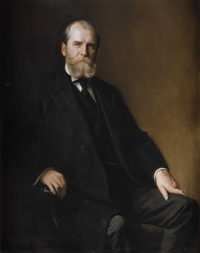
Hughes served as the Governor of New York from 1907 to 1910. He defeated William Randolph Hearst in the 1906 election, and was the only Republican statewide candidate to win office. An admirer of Britain's New Liberal philosophy, Hughes campaigned on a platform to improve the state of New York's standard of living by moving it away from laissez-faire tradition and enacting social reforms similar to that which had been enacted in Britain.[1] As a supporter of progressive policies, Hughes was able to play on the popularity of Theodore Roosevelt and weaken the power of the state's conservative Republican officials.[6] In 1908, he was offered the vice-presidential nomination by William Howard Taft, but he declined it to run again for Governor. Theodore Roosevelt became an important supporter of Hughes.[7]
As the Governor, Hughes produced important reform legislation in three areas: improvement of the machinery and processes of government; extension of the state's regulatory authority over businesses engaged in public services; and expansion of governmental police and welfare functions.[6] To counter political corruption, he secured campaign laws in 1906 and 1907 that limited political contributions by corporations and forced candidates to account for their receipts and expenses, legislation that was quickly copied in fifteen other states. He pushed the passage of the Moreland Act, which enabled the governor to oversee city and county officials as well as officials in semi-autonomous state bureaucracies. This allowed him to fire many corrupt officials. He also managed to have the powers of the state's Public Service Commissions increased and fought strenuously, if not completely successfully, to get their decisions exempted from judicial review.
When two bills were passed to reduce railroad fares, Hughes vetoed them on the grounds that the rates should be set by expert commissioners rather than by elected ones. His ideal was not government by the people but for the people. As Hughes put it, "you must have administration by administrative officers."[1]
Hughes, however, would be unsuccessful in achieving one of his main goals as governor: primary voting reform.[6] Hoping to achieve a compromise with the state's party bosses, Hughes rejected the option of a direct primary in which voters could choose between declared candidates and instead proposed a complicated system of nominations by party committees. The state's party bosses, however, rejected this compromise and the state legislature rejected the plan on three occasions in 1909 and 1910.
On social issues, Hughes strongly supported relatively limited social reforms. He endorsed the Page-Prentice Act of 1907, which set an eight-hour day and forty-eight-hour week for factory workers—but only for those under the age of sixteen. By employing the well-established legal distinction between ordinary and hazardous work, the governor also won legislative approval for a Dangerous Trades Act that barred young workers from thirty occupations. To enforce these and other regulations, in 1907 Hughes reorganized the Department of Labor and appointed a well-qualified commissioner. Two years later, the governor created a new bureau for immigrant issues in the Department of Labor and appointed reformer Frances Kellor to head it.
In his final year as the Governor, he had the state comptroller draw up an executive budget. This began a rationalization of state government and eventually it led to an enhancement of executive authority. He also signed the Worker's Compensation Act of 1910, which required a compulsory, employer-paid plan of compensation for workers injured in hazardous industries and a voluntary system for other workers; after the New York Court of Appeals ruled the law unconstitutional in 1911, a popular referendum was held that successfully made the law an amendment in the New York Constitution.
In 1908, Governor Hughes reviewed the clemency petition of Chester Gillette concerning the murder of Grace Brown. The governor denied the petition as well as an application for reprieve, and Gillette was electrocuted in March of that year.
When Hughes left office, a prominent journal remarked "One can distinctly see the coming of a New Statism ... [of which] Gov. Hughes has been a leading prophet and exponent". In 1926, Hughes was appointed by New York Governor Alfred E. Smith to be the chairman of a State Reorganization Commission through which Smith's plan to place the Governor as the head of a rationalized state government, was accomplished, bringing to realization what Hughes himself had envisioned.
In 1909, Hughes led an effort to incorporate Delta Upsilon fraternity. This was the first fraternity to incorporate, and he served as its first international president.
Associate Justice
On April 25, 1910, President William H. Taft nominated Hughes for Associate Justice to fill the vacancy left by the death of Justice David J. Brewer. The Senate confirmed the nomination on May 2, 1910, and Hughes received his commission the same day. As an associate justice of the Supreme Court from 1910 to 1916, Hughes remained an advocate of regulation and authored decisions that weakened the legal foundations of laissez-faire capitalism. He also mastered a new set of issues regarding the Commerce Clause and, in a deliberately restrained manner, wrote constitutional decisions that expanded the regulatory powers of both the state and federal governments.
He wrote for the court in Bailey v. Alabama 219 U.S. 219 (1911),[8] which held that involuntary servitude encompassed more than just slavery, and Interstate Commerce Comm. v. Atchison T & SF R Co. 234 U.S. 294 (1914),[9] holding that the Interstate Commerce Commission could regulate intrastate rates if they were significantly intertwined with interstate commerce.
On April 15, 1915 in the case of Frank v. Mangum,[10] the Supreme Court decided (7-2) to deny an appeal made by Leo Frank's attorneys, and instead upheld the decision of lower courts to sustain the guilty verdict against Frank. Justice Hughes and Justice Oliver Wendell Holmes Jr. were the two dissenting votes.
Presidential candidate
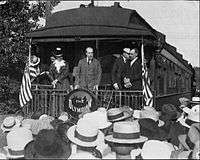
Hughes resigned from the Supreme Court on June 10, 1916,[11] to be the Republican candidate for President in 1916. He is the last sitting Supreme Court justice to surrender his or her seat to run for elected office. He was also endorsed by the Progressive Party,[12] thanks to the support given to him from former President Theodore Roosevelt. Other Republican figures such as former President William Howard Taft endorsed Hughes and felt the accomplishments he made as Governor of New York would establish him as formidable progressive alternative to Wilson.[1] Many former leaders of the Progressive Party, however, endorsed Wilson because Hughes opposed the Adamson Act, the Sixteenth Amendment and diverted his focus away from progressive issues during the course of the campaign.[1] Hughes was defeated by Woodrow Wilson in a close election (separated by 23 electoral votes and 594,188 popular votes). The election hinged on California, where Wilson managed to win by 3,800 votes and its 13 electoral votes and thus was returned for a second term; Hughes had lost the endorsement of the California governor and Roosevelt's 1912 Progressive running mate Hiram Johnson when he failed to show up for an appointment with him.
Despite coming close to winning the presidency, Hughes did not seek the Republican nomination again in 1920. Hughes also advocated ways to prevent the return of President Wilson's expanded government control over important industries such as the nation's railroads,[1] which he felt would lead to the eventual destruction of individualism and political self-rule.[1] After Robert LaFollette's Progressive Party advocated the return of such regulations during the 1924 US Presidential election, Hughes shifted rightwards believing that the federal bureaucracy should now have limited powers over individual liberties and property rights and that common law should be strictly enforced.[1]
Secretary of State
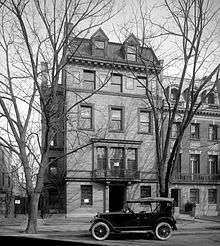
Hughes returned to government office in March 1921 as Secretary of State under President Harding. On November 11, 1921, Armistice Day (later changed to Veterans Day), the Washington Naval Conference for the limitation of naval armament among the Great Powers began. The major naval powers of Britain, France, Italy, Japan and the United States were in attendance as well as other nations with concerns about territories in the Pacific — Belgium, the Netherlands, Portugal and China.[13]
The American delegation was headed by Hughes and included Elihu Root, Henry Cabot Lodge, and Oscar Underwood, the Democratic minority leader in the Senate. The conference continued until February 1922 and included the Four-power pact (December 13, 1921), Shantung Treaty (February 4, 1922), Five-Power Treaty, the Nine-Power Treaty (February 6, 1922), the "Six-power pact" that was an agreement between the Big Five Nations plus China to divide the German cable routes in the Pacific, and the Yap Island agreement.[14]
Hughes continued in office after Harding died and was succeeded by Coolidge, but resigned after Coolidge was elected to a full term. On June 30, 1922, he signed the Hughes–Peynado agreement that ended the United States's six-year occupation of Dominican Republic.[15]
Various appointments
In 1907, Gov. Charles Evans Hughes became the first president of the newly formed Northern Baptist Convention—based at Calvary Baptist Church in Washington, DC, of which Hughes was a member. He also served as President of the New York State Bar Association.
After leaving the State Department, he again rejoined his old partners at the Hughes firm, which included his son and future United States Solicitor General Charles E. Hughes Jr., and was one of the nation's most sought-after advocates. From 1925 to 1930, for example, Hughes argued over 50 times before the U.S. Supreme Court. From 1926 to 1930, Hughes also served as a member of the Permanent Court of Arbitration and as a judge of the Permanent Court of International Justice in The Hague, Netherlands from 1928 to 1930. He was additionally a delegate to the Pan American Conference on Arbitration and Conciliation from 1928 to 1930. He was one of the co-founders in 1927 of the National Conference on Christians and Jews, now known as the National Conference for Community and Justice (NCCJ), along with S. Parkes Cadman and others, to oppose the Ku Klux Klan, anti-Catholicism, and anti-Semitism in the 1920s and 1930s.[16]
In 1925–1926, Charles Evans Hughes represented the API (American Petroleum Institute) before the FOCB (Federal Oil Conservation Board).[17]
In 1928 conservative business interests tried to interest Hughes in the GOP presidential nomination of 1928 instead of Herbert Hoover. Hughes, citing his age, turned down the offer.
Chief Justice

Herbert Hoover, who had appointed Hughes's son as Solicitor General in 1929, appointed Hughes Chief Justice of the United States on February 3, 1930. Hughes was confirmed by the United States Senate on February 13, 1930, and received commission the same day, serving in this capacity until 1941. Hughes replaced former President William Howard Taft, a fellow Republican who had also lost a presidential election to Woodrow Wilson (in 1912) and who, in 1910, had appointed Hughes to his first tenure on the Supreme Court.
Hughes' appointment was opposed by progressive elements in both parties who felt that he was too friendly to big business. Idaho Republican William E. Borah said on the United States Senate floor that confirming Hughes would constitute "placing upon the Court as Chief Justice one whose views are known upon these vital and important questions and whose views, in my opinion, however sincerely entertained, are not which ought to be incorporated in and made a permanent part of our legal and economic system."[18] In addition to his politics, at 67, Hughes was the oldest man ever nominated as Chief Justice.[19] Nonetheless Hughes was confirmed as Chief Justice with a vote of 52 to 26.
Hughes as Chief Justice swore in President Franklin D. Roosevelt in 1933, 1937 and 1941.
Upon his return to the court, more progressives had joined the bench. Hughes seemed determined again to vote progressive and soon bring an end to the longstanding pro-business Lochner era.[1] During his early years as Chief Justice, however, the fear he had developed for an overblown bureaucracy during World War I undermined his optimism.[1] Showing his old progressive image, he upheld legislation protecting civil rights and civil liberties[1] and wrote the opinion for the Court in Near v. Minnesota 283 U.S. 697 (1931), which held prior restraint against the press is unconstitutional. Concerning economic regulation, he was still willing to uphold legislation that supported "freedom of opportunity" for individuals on the one hand and the "police power" of the state on the other[1] but did not personally favor legislation that linked national economic planning and bureaucratic social welfare together.[1] At first resisting Roosevelt's New Deal and building a consensus of centrist members of the court, Hughes used his influence to limit the collectivist scope of Roosevelt's changes[1] and would often strike down New Deal legislation he felt was poorly drafted and did not clearly specify how they were constitutional.[20] By 1935, Hughes felt the court's four conservative Justices had disregarded common law and sought to curb their power.[1]
Hughes was often aligned with the court's three liberal Justices — Louis Brandeis, Harlan Fiske Stone, and Benjamin Cardozo — in finding some New Deal measures (such as the violation of the gold clauses in contracts and the confiscation of privately owned monetary gold) constitutional.[1] On one occasion, Hughes would side with the conservatives in striking down the New Deal's Agricultural Adjustment Act in the 1936 case United States v. Butler,[1] which held that the law was unconstitutional because its so-called tax policy was a coercive regulation rather than a tax measure and the federal government lacked authority to regulate agriculture.[1] But surprisingly he did not assign the majority opinion,[1] a practice usually required for court's most senior justice who agrees with the majority opinion,[21][22] and allowed Associate Justice Owen Roberts to speak for the entire majority in his own words.[1] It was accepted that he did not agree with the argument that the federal government lacked authority over agriculture and was going to write a separate opinion upholding the act's regulation policy while striking down the act's taxation policy on the grounds that it was a coercive regulation rather than a tax measure.[1] However, Roberts convinced Hughes that he would side with him and the three liberal justices in future cases pertaining to the nation's agriculture that involved the Constitution's General Welfare Clause if he agreed to join his opinion.[1]
By 1936, Hughes sensed the growing hostility in the court and could do little about it.[1] In the 1936 case Carter v. Carter Coal Company, Hughes took a middle ground for doctrinal and court-management reasons.[1] Writing his own opinion, he joined the three liberal justices in upholding the Bituminous Coal Conservation Act's marketing provision but sided with Roberts and the four conservatives in striking down the act's provision that regulated local labor.[1] By 1937, as the court leaned more in his favor, Hughes would renounce the position he took in the Carter case regarding local labor and ruled that the procedural methods that governed the Wagner Act's labor regulation provisions bore resemblance to the procedural methods which governed the railroad rates that the Interstate Commerce Commission was allowed to maintain in the 1914 Shreveport decision; he thus demonstrated that Congress could use its commerce power to regulate local industrial labor as well.[1]
In 1937, when Roosevelt attempted to pack the Court with six additional justices, Hughes worked behind the scenes to defeat the effort,[23][23] which failed in the Senate,[23] by rushing important New Deal legislation — such as Wagner Act and the Social Security Act — through the court and ensuring that the court's majority would uphold their constitutionality.[1] The month after Roosevelt's court-packing announcement, Roberts, who had joined the four conservative Justices in striking down important New Deal legislation, shocked the American public by siding with Hughes and the court's three liberal justices in striking down the court's ruling in the 1923 Adkins v. Children's Hospital case — which held that laws requiring minimum wage violated the Fifth Amendment's due process clause — and upholding the constitutionality of Washington state's minimum wage law in West Coast Hotel Co. v. Parrish. Because Roberts had previously sided with the four conservative justices and used the Adkins decision as the basis for striking down a similar minimum wage law the state of New York enforced in Morehead v. New York ex rel. Tipaldo,[24] it was widely perceived that he only agreed to uphold the constitutionality of minimum wage as a result of the pressure that was put on the Supreme Court by the court-packing plan.[25] However, Hughes and Roberts acknowledged that the Chief Justice had already convinced Roberts to change his method of voting months before Roosevelt announced his court-packing plan[20][26] and that the effort he put into defeating the plan played only a small significance in determining how the court's majority made their decisions in future cases pertaining to New Deal legislation.[26]
Following the overwhelming support that voters showed for the New Deal through Roosevelt's overwhelming re-election in November 1936,[20] Hughes was not able to persuade Roberts to base his votes on political maneuvering and to side with him in future cases regarding New Deal-related policies.[20][26] Roberts had voted to grant certiorari to hear the Parrish case before the election of 1936.[27] Oral arguments occurred on December 16 and 17, 1936, with counsel for Parrish specifically asking the court to reconsider its decision in Adkins v. Children's Hospital,[28] which had been the basis for striking down a New York minimum wage law in Morehead v. New York ex rel. Tipaldo[24] in the late spring of 1936.[29]
Roberts indicated his desire to overturn Adkins immediately after oral arguments ended for the Parrish case on December 17, 1936.[29] The initial conference vote on December 19, 1936 was 4-4; with this even division on the Court, the holding of the Washington Supreme Court, finding the minimum wage statute constitutional, would stand.[30] The eight voting justices anticipated Justice Stone — absent due to illness — would be the fifth vote necessary for a majority opinion affirming the constitutionality of the minimum wage law.[30] As Hughes desired a clear and strong 5-4 affirmation of the Washington Supreme Court's judgment, rather than a 4-4 default affirmation, he convinced the other justices to wait until Stone's return before deciding and announcing the case.[30] In one of his notes from 1936, Hughes wrote that Roosevelt's re-election forced the court to depart from its "fortress in public opinion" and severely weakened its capability to base its rulings on personal or political beliefs.[20]
President Roosevelt announced his court reform bill on February 5, 1937, the day of the first conference vote after Stone's February 1, 1937 return to the bench. Roosevelt later made his justifications for the bill to the public on March 9, 1937 during his ninth Fireside Chat. The Court's opinion in Parrish was not published until March 29, 1937, after Roosevelt's radio address. Hughes wrote in his autobiographical notes that Roosevelt's court reform proposal "had not the slightest effect on our [the court's] decision,"[25] but due to the delayed announcement of its decision the Court was characterized as retreating under fire.[25]
Although Hughes wrote the opinion invalidating the National Recovery Administration in Schechter Poultry Corp. v. United States — though the decision was unanimously upheld by all of the court's Justices[1] — he also wrote the opinions for the Court in NLRB v. Jones & Laughlin Steel Corp.,[31] NLRB v. Friedman-Harry Marks Clothing Co.[32] and West Coast Hotel Co. v. Parrish[33] which approved some New Deal measures. Hughes supervised the move of the Court from its former quarters at the U.S. Capitol to the newly constructed Supreme Court building.
Hughes wrote 199 majority opinions in his time on the bench, from 1930 to 1941. "His opinions, in the view of one commentator, were concise and admirable, placing Hughes in the pantheon of great justices."[34] His "remarkable intellectual and social gifts...made him a superb leader and administrator. He had a photographic memory that few, if any, of his colleagues could match. Yet he was generous, kind, and forebearing in an institution where egos generally come in only one size: extra large!"[34]
Later life
For many years, he was a member of the Union League Club of New York and served as its president from 1917 to 1919.
In 1907 Hughes, then the Governor of New York, was elected to honorary membership in the Empire State Society of the Sons of the American Revolution. He was assigned national membership number 18,977.
On August 27, 1948, at the age of 86, Hughes died in what is now the Tiffany Cottage of the Wianno Club in Osterville, Massachusetts. He is interred at Woodlawn Cemetery in The Bronx, New York City.[35]
Tributes
- The Charles Evans Hughes House, now the Burmese ambassador's residence, in Washington, D.C. was declared a National Historic Landmark in 1972. Hughes lived in the home from 1930 until his death in 1948.
- Most Hughes papers are in the collection of the Manuscript Division of the Library of Congress.[36] However, other items that could be involved in research are at institutions around the country.[37]
- On the 100th anniversary of Hughes' birth the U.S. Post Office issued a commemorative stamp in his honor, on April 11, 1962, in Washington, DC.[38]
- Charles Evans Hughes Junior High School (of Woodland Hills, California, now closed) was named in his honor, as was the Hughes Range in Antarctica.
- Charles Evans Hughes High School (of New York City) was named in his honor. It was later renamed High School for the Humanities.
- Hughes Hall is a dormitory at the Cornell Law School, where he once taught.
- Charles Evans Hughes Middle School in Long Beach, California, was named in his honor.
- A bust-length portrait of Hughes by the Swiss-born American portrait painter Adolfo Müller-Ury (1862–1947) is in the Michigan Historical Museum in Lansing, Michigan. It was accessioned by them in 1939–1940 but probably acquired earlier.
- The New York City Bar Association has a room named after Charles Evans Hughes. Two portraits of him are hung in this room as well as one of his son, Charles Evans Hughes Jr.
- The Union League Club of New York, of which Hughes was once president, dedicated the Hughes Room in his honor featuring a portrait of him.
- Hughes Court, an area of the Wriston Quadrangle at Brown University, is named for him.
See also
- Demographics of the Supreme Court of the United States
- List of Justices of the Supreme Court of the United States
- List of law clerks of the Supreme Court of the United States
- List of U.S. Supreme Court Justices by time in office
- List of United States Chief Justices by time in office
- United States Supreme Court cases during the Hughes Court
- United States Supreme Court cases during the White Court
- United States Constitution, Separation of powers
References
- Citations
- 1 2 3 4 5 6 7 8 9 10 11 12 13 14 15 16 17 18 19 20 21 22 23 24 25 26 27 28 29 "Charles Evans Hughes and the Strange Death of Liberal America". Archived from the original on March 9, 2012. Retrieved 24 November 2013.
- ↑ Clinton Rossiter, Conservatism in America (1962) p. 174
- ↑ Ross 2007, p. 2
- ↑ "Elizabeth Hughes: Fifty-eight years on animal-insulin". Retrieved 24 November 2013.
- ↑ "Stevens gas committee". The New York Times. 27 April 1905. Retrieved 24 November 2013.
- 1 2 3 "Charles Evans Hughes". Retrieved 24 November 2013.
- ↑ Schizer, David M. "Welcoming the J.D. Class of 2014", address at Columbia Law School, August 2011, p. 4.
- ↑ "Findlaw Bailey v. Alabama". Retrieved 24 November 2013.
- ↑ "Interstate Commerce Comm. v. Atchison T & SF R Co.". Retrieved 24 November 2013.
- ↑ "Leagle; Frank v. Mangum". Archived from the original on 2012-01-18. Retrieved 24 November 2013.
- ↑ Supreme Court of the United States Accessed December 13, 2007.
- ↑ Eisler, a Justice for All, page 39, ISBN 0-671-76787-9
- ↑ "Washington Naval Conference". Retrieved 24 November 2013.
- ↑ "Text of the Agreement Reached on Yap And Other Mandated Pacific Islands". New York Times. 1921-12-13. Retrieved 24 November 2013.
- ↑ Calder, Bruce J. (1984). The impact of intervention: the Dominican Republic during the U.S. occupation of 1916-1924. Markus Wiener Publishers. p. 223. ISBN 978-1-55876-386-9. Retrieved 22 September 2011.
- ↑ "National Conference for Community and Justice". Archived from the original on 6 June 2007. Retrieved 19 December 2007.
- ↑ Federal Oil Conservation Board. Complete Record of Public Hearings. Washington D.C.: Government Printing Office. p. 155.
February 10 and 11, 1926
- ↑ Wittes 2006, p. 50
- ↑ "Herbert Hoover and the Supreme Court". The Presidential Timeline. The U.S. National Archives and Records Administration. Retrieved December 11, 2015.
- 1 2 3 4 5 Devins, Neal (1996). "Government Lawyers and the New Deal". William & Mary Law School. Retrieved 24 November 2013.
- ↑ "The Chief Justices and Self-Assignment of Majority Opinions: A Research Note". Retrieved 24 November 2013.
- ↑ "Lee Epstein". Retrieved 24 November 2013.
- 1 2 3 Jeff Shesol, Supreme power: Franklin Roosevelt vs. the Supreme Court (2010) pp. 394–7.
- 1 2 298 U.S. 587 (1936)
- 1 2 3 McKenna, Marian C. (2002). Franklin Roosevelt and the Great Constitutional War: The Court-packing Crisis of 1937. New York, NY: Fordham University Press. p. 419. ISBN 978-0-8232-2154-7.
- 1 2 3 McKenna, Marian C. (2002). Franklin Roosevelt and the Great Constitutional War: The Court-packing Crisis of 1937. New York, NY: Fordham University Press. pp. 422–23. ISBN 978-0-8232-2154-7.
- ↑ McKenna, Marian C. (2002). Franklin Roosevelt and the Great Constitutional War: The Court-packing Crisis of 1937. New York, NY: Fordham University Press. pp. 412–13. ISBN 978-0-8232-2154-7.
- ↑ 261 U.S. 525 (1923)
- 1 2 McKenna, Marian C. (2002). Franklin Roosevelt and the Great Constitutional War: The Court-packing Crisis of 1937. New York, NY: Fordham University Press. p. 413. ISBN 978-0-8232-2154-7.
- 1 2 3 McKenna, Marian C. (2002). Franklin Roosevelt and the Great Constitutional War: The Court-packing Crisis of 1937. New York, NY: Fordham University Press. p. 414. ISBN 978-0-8232-2154-7.
- ↑ "N.L.R.B. v. JONES & LAUGHLIN STEEL CORP., 301 U.S. 1 (1937)". Retrieved 24 November 2013.
- ↑ "Findlaw; NLRB v. Friedman-Harry Marks Clothing Co". Retrieved 24 November 2013.
- ↑ "Findlaw; West Coast hotel v. Parrish". Retrieved 24 November 2013.
- 1 2 "Charles Evans Hughes". Official Supreme Court media at Oyez project. Retrieved 24 November 2013.
- ↑ "Christensen, George A. (1983) Here Lies the Supreme Court: Gravesites of the Justices, Yearbook". Supreme Court Historical Society. Archived from the original on 2005-09-03. Retrieved 24 November 2013.
- ↑ Library of Congress, Charles Evans Hughes collection. Archived April 5, 2010, at the Wayback Machine.
- ↑ Federal Judicial Center, Hughes Reference materials. Archived May 15, 2009, at the Wayback Machine.
- ↑ "Charles Evans Hughes Issue". Smithsonian national Postal Museum. Retrieved 24 November 2013.
- Bibliography
- Ross, William G. (2007). The Chief Justiceship of Charles Evans Hughes, 1930-1941. Columbia, SC: University of South Carolina Press. ISBN 978-1570036798.
- Wittes, Benjamin (2006). Confirmation Wars: Preserving Independent Courts in Angry Times. Rowman & Littlefield. ISBN 978-0-7425-5144-2.
Further reading
- The Recall of Justice Hughes (May, 1916) The World's Work.
- Abraham, Henry J., Justices and Presidents: A Political History of Appointments to the Supreme Court. 3d. ed. (Oxford, Oxfordshire: Oxford University Press, 1992). ISBN 0-19-506557-3.
- Cushman, Clare, The Supreme Court Justices: Illustrated Biographies,1789–1995 (2nd ed.) (Supreme Court Historical Society), (Congressional Quarterly Books, 2001) ISBN 1-56802-126-7; ISBN 978-1-56802-126-3.
- Ernst, Daniel R. Tocqueville's Nightmare: The Administrative State Emerges in America, 1900-1940 (Oxford University Press, 2014).
- Frank, John P., The Justices of the United States Supreme Court: Their Lives and Major Opinions (Leon Friedman and Fred L. Israel, editors) (Chelsea House Publishers, 1995) ISBN 0-7910-1377-4, ISBN 978-0-7910-1377-9.
- Glad, Betty, Charles Evans Hughes and the illusions of innocence: A study in American diplomacy (Urbana, IL: University of Illinois Press, 1966).
- Hall, Kermit L., ed. The Oxford Companion to the Supreme Court of the United States. Oxford, Oxfordshire: Oxford University Press, 1992. ISBN 0-19-505835-6; ISBN 978-0-19-505835-2.
- Martin, Fenton S. and Goehlert, Robert U., The U.S. Supreme Court: A Bibliography, (Congressional Quarterly Books, 1990). ISBN 0-87187-554-3.
- Perkins, Dexter, Charles Evans Hughes and American democratic statesmanship (Boston: Little, Brown, 1956).
- Pusey, Merlo J., Charles Evans Hughes, 2 vol. (New York: Macmillan, 1951).. the standard scholarly biography
- Shesol, Jeff. Supreme Power: Franklin Roosevelt vs. The Supreme Court (W.W. Norton, 2010)
- Simon, James F., FDR and Chief Justice Hughes: The President, the Supreme Court, and the Epic Battle Over the New Deal (Simon & Schuster, Forthcoming, February 2012).
- Urofsky, Melvin I., The Supreme Court Justices: A Biographical Dictionary (New York: Garland Publishing 1994). 590 pp. ISBN 0-8153-1176-1; ISBN 978-0-8153-1176-8.
- Wesser, Robert F., Charles Evans Hughes: Politics and reform in New York, 1905–1910 (Ithaca, NY: Cornell University Press, 1967).
- Henretta, James A., Charles Evans Hughes and the Strange Death of Liberal America, (University of Illinois Law and History Review, Spring 2006, Vol. 24, No. 1)
External links
| Wikimedia Commons has media related to Charles Evans Hughes. |
| Wikiquote has quotations related to: Charles Evans Hughes |
| Wikisource has original works written by or about: Charles Evans Hughes |
- Grave of Charles Evans Hughes at Find a Grave
- The Hughes Court at Supreme Court Historical Society.
- "Charles Evans Hughes, Presidential Contender" from C-SPAN's The Contenders
- Archives
- Judge Manuscript Information: Charles Evans Hughes. List of archives with documents via Judges of the United States Courts. Retrieved April 15, 2005.
- Archives at the Supreme Court Historical Society
- Legal opinions as Chief Justice
- Near v. Minnesota ex rel. Olson, 283 U.S. 697 (1931).
- Schechter Poultry Corp. v. United States, 295 U.S. 495 (1935).
- NLRB v. Jones & Laughlin Steel Corp., 301 U.S. 1 (1937).
- West Coast Hotel v. Parrish, 300 U.S. 379 (1937)
- Books
| Party political offices | ||
|---|---|---|
| Preceded by Frank Higgins |
Republican nominee for Governor of New York 1906, 1908 |
Succeeded by Henry Stimson |
| Preceded by William Taft |
Republican nominee for President of the United States 1916 |
Succeeded by Warren Harding |
| Political offices | ||
| Preceded by Frank Higgins |
Governor of New York 1907–1910 |
Succeeded by Horace White |
| Preceded by Bainbridge Colby |
United States Secretary of State 1921–1925 |
Succeeded by Frank Kellogg |
| Legal offices | ||
| Preceded by David Brewer |
Associate Justice of the Supreme Court of the United States 1910–1916 |
Succeeded by John Clarke |
| Preceded by William Taft |
Chief Justice of the United States 1930–1941 |
Succeeded by Harlan Stone |
| Non-profit organization positions | ||
| Preceded by Lawson Purdy |
President of the National Municipal League 1919–1921 |
Succeeded by Henry M. Waite |
| Awards and achievements | ||
| Preceded by Alfonso XIII of Spain |
Cover of Time 29 December 1924 |
Succeeded by Juan Belmonte |
| | |||||||||||||||||||||||||||||||
|---|---|---|---|---|---|---|---|---|---|---|---|---|---|---|---|---|---|---|---|---|---|---|---|---|---|---|---|---|---|---|---|
|
 | ||||||||||||||||||||||||||||||
